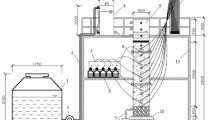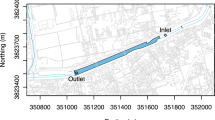Abstract
Hydraulic characteristics of a river are the key factors for river water quality improvement and river restoration. A simulated river was exploited to study the interactions between water contaminant purification coefficients and the characteristics of the river, such as the cross-section velocity, water depth, Reynolds number, and Froude number. To enhance the purification capacity of the river, detritus with 5 mm to 10 mm in diameter and contact surface area per volume of 87.6 m2/m3 were constructed naturally at the bed and along one side of the bank to form half shape of the river cross-section. During the one-month experiment (including 3 periods) from the third of November to the fourth of December, 2005, three categories of hydraulic conditions were investigated. Results show that the purification coefficient (K) of Total Nitrogen (TN) is closely coherent with the hydraulic retention time (T), river length (L), Reynolds number (Re) and Froude number (Fr). The relationship of K and T generally agrees with the power law under the three experimental water hydraulic conditions. Based on these results, the optimal Re and Fr ranges can be obtain to serve as a guideline for ecological re-engineering design to improve river water quality and restore river ecosystem.
Similar content being viewed by others
References
DAVID A. Kovacic, RICHARD M. Twait, MICHAEL P. Wallace et al. Use of created wetlands to improve water quality in the midwest — Lake Bloomington case study[J]. Ecol. Eng., 2006, 28(3): 258–270.
MARIET M. Hefting, JEAN-CHRISTOPHE Clement, PIOTR Bienkowski et al. The role of vegetation and litter in the nitrogen dynamics of riparian buffer zones in Europe[J]. Ecol. Eng., 2005, 24(5): 465–482.
SHIELDS F. D., COOPER Jr. C. M., KNIGHT S.S. et al. Stream corridor restoration research: a long and winding road [J]. Ecol. Eng., 2003, 20(5): 441–454.
GU Feng-feng, NI Han-gen. The effects of the reeds density on flow resistance[J]. Journal of Hydrodynamics, Ser. A, 2006, 21(5): 626–632(in Chinese).
BOCKELMANN B. N., FENRICH E. K., LIN B. et al. Development of an ecohydraulics model for stream and river restoration[J]. Ecol. Eng., 2004, 22: 227–235.
NEHAL Laounia, YAN Zhong-min, XIA Ji-hong. Study of the flow through non-submerged vegetation[J]. Journal of Hydrodynamics, Ser. B, 2005, 17(4): 498–502.
WANG Chao, ZHU Ping, WANG Pei-fang et al. Effects of aquatic vegetation on flow in the Nansi Lake and its flow velocity modeling[J]. Journal of Hydrodynamics, Ser. B, 2006, 18(6): 641–652.
ELISABETTA Giusti, STEFANO Marsili-Libelli. Modelling the interactions between nutrients and the submersed vegetation in the Orbetello Lagoon[J]. Ecological Modelling, 2005, 184(1): 141–161.
WANG Chao, WANG Yan-ying, WANG Pei-fang. Water quality modeling and pollution control for the eastern route of south to north water transfer project in china[J]. Journal of Hydrodynamics, Ser. B, 2006, 18(3): 253–261.
LIU Xiao-dong, HUA Zu-lin. Numerical simulation for shallow flow and pollutant dispersion based on quad-tree meshes[J]. Journal of Hydrodynamics, Ser. B, 2006, 18(2): 161–169.
WANG Hui-min. ZHAO Zhen-xing. Engineering fluid mechanics[M]. Nanjing: Hohai University Press, 2004.(in Chinese).
SHAMLOO H., RAJARATNAM N., KATOPODIS C. Hydraulics of simple habitat structures[J]. Journal of Hydraulic Research, 2001, 39(4): 351–366.
SCHULZ Marcus, RINKE Karina, KÖHLER Jan. A combined approach of photogrammetrical methods and field studies to determine nutrient retention by submersed macrophytes in running waters[J]. Aquatic Botany, 2003, 76(1): 17–29.
LIANG Bing-chen, LEE Dong-yong, LI Hua-jun et al. Theory and numerical analysis of the interaction between turbulence and suspended sediment[J]. Journal of Hydrodynamics, Ser. B, 2005, 17(5): 532–538.
MU Jin-bo, HAN Yan-zhu. BOD degradation coefficient in Nansi Lake and input rivers[J]. Jiangsu Environmental Technology, 1996, (2): 7–10(in Chinese).
MA Yao-guang, LI Shu-qin, YANG Xuan-zheng et al. The degradation characteristic of organic polluants in the Jinghe River[J]. Agriculatual Research in the Arid Areas, 2003, 21(1): 126–128(in Chinese).
WANG You-le, ZHOU Zhi-fang, WANG Li-jing et al. Test on degradation coefficient of ammonia-nitrogen in Yellow River adjacent to Lanzhou[J]. Journal of Lanzhou University of Technology, 2006, 32(5): 72–74(in Chinese).
FENG Su-ping, ZOU Xiao-dong, ZHU Ying et al. Study on the law of BOD 1-20 degradation in Dawen River system[J]. Journal of Shandong University, 2004, 39(5): 95–98(in Chinese).
FU Guo-wei, CHENG Sheng-tong, Programming of water pollution control[M]. Beijing: Tsinghua University Press, 1985(in Chinese).
YAN Xu-shi, FAN Jin-chu. Water treatment engineering[M]. Beijing: China Architecture Industry Press, 1999(in Chinese).
WANG Chao, WANG Pei-fang, TANG Jin-song et al. Ammonia sorption and retention characters in the riparian reed zone[J]. Advances in Water Science, 2003, 14(3): 311–317(in Chinese).
Author information
Authors and Affiliations
Corresponding author
Additional information
Project supported by the National Basic Research Program of China (973 program, Grant No. 2002CB412303), the Project of Ministry of Education (Grant No. 106088), and the Science Foundation of Hohai University (Grant No. 406077).
Biography: Wang Pei-fang (1973-), Female, Ph. D., Associate Professor
Rights and permissions
About this article
Cite this article
Wang, Pf., Wang, Xr. & Wang, C. Experiment of Impact of River Hydraulic Characteristics on Nutrients Purification Coefficient. J Hydrodyn 19, 387–393 (2007). https://doi.org/10.1016/S1001-6058(07)60074-2
Received:
Revised:
Published:
Issue Date:
DOI: https://doi.org/10.1016/S1001-6058(07)60074-2




